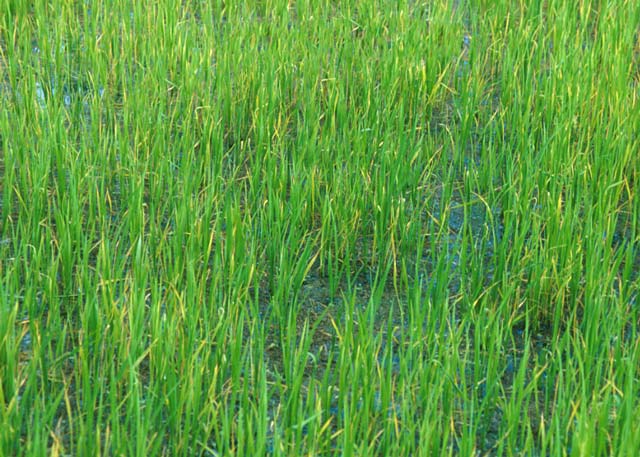Nitrogen (N) deficiency
 What it does
What it does
Nitrogen (N) deficient crops have low yield.
Why and where it occurs
Nitrogen deficiency is one of the most common problems in rice in Asia. It is common in all rice-growing soils where modern varieties are grown without sufficient mineral N fertilizer.
It often occurs at critical growth stages of the plant, such as tillering and panicle initiation, when the demand for nitrogen is large.
Nitrogen deficiency may also occur where a large amount of N fertilizer has been applied but at the wrong time or in the wrong way. Soils particularly prone to N deficiency include the following types:
- soils with very low soil organic matter content
- soils with particular constraints to indigenous N supply (e.g., acid sulfate soils, saline soils, Phosphorus (P)-deficient soils, poorly drained wetland soils)
- alkaline and calcareous soils with low soil organic matter status and a high potential for ammonia (NH3) volatilization losses
How to identify

Check the field for abnormalities. N deficient crops are stunted and discolored. Specifically:
- older leaves or whole plants are yellowish green
- old leaves and sometimes all leaves become light green and chlorotic at the tip
- entire field may appear yellowish
Check the leaves for the following symptoms.
- Leaves can die under severe N stress. Except for young leaves, which are greener, leaves of nitrogen deficient plants are narrow, small, short, erect, and lemon-yellowish green.
- Other symptoms are reduced tillering and reduced grain number.
The visual symptoms of N deficiency can be confused with those of Sulfur (S) deficiency, but S deficiency is less common and tends to first affect younger leaves or all leaves on the plant. Mild N deficiency can be confused with Fe deficiency, but the latter affects the emerging leaf first.
To confirm cause of problem, bring soil and plant sample to the laboratory for testing.
Why is it important
Nitrogen deficiency is probably the most common problem in rice and tends to be of large economic significance. Fertilizer as a percent of costs per ha varies considerably, from 10−20% in irrigated rice in a range of countries.
How to manage
- Apply N fertilizer efficiently.
- Do not apply large amounts of N to less responsive varieties.
Hybrid rice absorbs mineral N more efficiently than inbred rice varieties. - Choose a suitable plant spacing for each cultivar. Crops with suboptimal plant densities do not use fertilizer N efficiently.
- Adjust the number of splits and timing of N applications according to the crop establishment method. Transplanted and direct-seeded rice require different N management strategies.
- Maintain proper water control, i.e., keep the field flooded to prevent denitrification but avoid N losses from water runoff over bunds immediately following fertilizer application.
- Establish a dense, healthy rice crop by using high-quality seed of a high-yielding variety with multiple pest resistance and a suitable plant density.
- Control weeds that compete with rice for N.
Where possible,
- Correct deficiencies of other nutrients (P, Potassium, and Zinc) and solve other soil problems (shallow rooting depth, toxicities).
- Over the long term, maintain or increase the supply of N from indigenous sources through proper organic matter management:
- Apply available organic materials (farmyard manure, crop residues, compost) on soils containing a small amount of organic matter, particularly in rainfed lowland rice and intensive irrigated rice systems where rice is rotated with other upland crops such as wheat or maize.
- In irrigated rice-rice systems, carry out dry, shallow tillage (5−10 cm) within two weeks of harvest. Early tillage enhances soil oxidation and crop residue decomposition during fallow and increases N availability up to the vegetative growth phase of the succeeding rice crop.
- Increase the indigenous N-supplying power of permanently submerged soils by periodic drainage and drying.